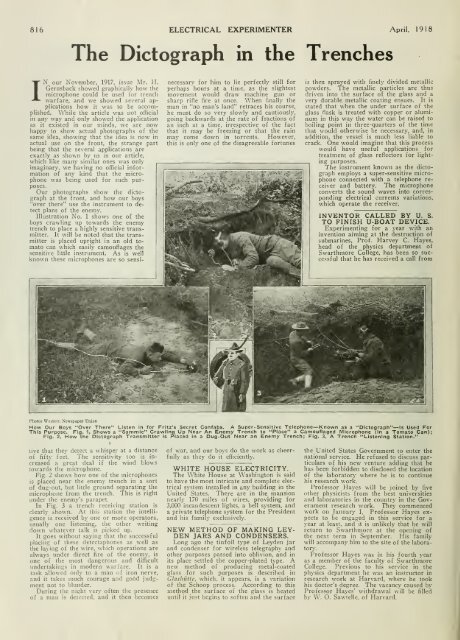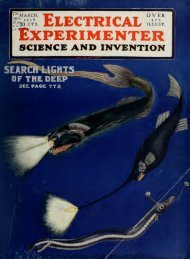The Electrical experimenter
The Electrical experimenter
The Electrical experimenter
Create successful ePaper yourself
Turn your PDF publications into a flip-book with our unique Google optimized e-Paper software.
816 ELECTRICAL EXPERIMENTER April, 1918<br />
IN<br />
<strong>The</strong> Dictograph in the Trenches<br />
our November, 1917, issue Mr. H.<br />
Gernsback showed graphically how the<br />
microphone could be used for trench<br />
warfare, and we showed several applications<br />
how it was to be accomplished.<br />
While the article was not official<br />
in any way and only showed the application<br />
as it existed in our minds, we are now<br />
happy to show actual photographs of the<br />
same idea, showing that the idea is now in<br />
actual use on the front, the strange part<br />
being that the several applications are<br />
exactly as shown by us in our article,<br />
which like many similar ones was only<br />
imaginary, we having no official information<br />
of any kind that the microphoneposes.<br />
was being used for such pur-<br />
Our photographs show the dictograph<br />
at the front, and how our boys<br />
"over there" use the instrument to detect<br />
plans of the enemy.<br />
Illustration No. 1 shows one of the<br />
boys crawling up towards the enemy<br />
trench to place a highly sensitive transmitter.<br />
It will be noted that the transmitter<br />
is placed upright in an old tomato<br />
can which easily camouflages the<br />
sensitive little instrument. As is well<br />
known these microphones are so sensi-<br />
necessary for him to lie perfectly still for<br />
perhaps hours at a time, as the slightest<br />
movement would draw machine gun or<br />
sharp rifle fire at once. When finally the<br />
man in "no man's land" retraces his course,<br />
he must do so very slowly and cautiously,<br />
going backwards at the rate of fractions of<br />
an inch at a time, irrespective of the fact<br />
that it may be freezing or that the rain<br />
may come down in torrents. However,<br />
this is only one of the disagreeable fortunes<br />
is then sprayed with finely divided metallic<br />
powders. <strong>The</strong> metallic particles are thus<br />
driven into the surface of the glass and a<br />
very durable metallic coating ensues. It is<br />
stated that when the under surface of the<br />
glass flask is treated with copper or aluminum<br />
in this way the water can be raised to<br />
boiling point in three-quarters of the time<br />
that would otherwise be necessary', and, in<br />
addition, the vessel is much less liable to<br />
crack. One would imagine that this process<br />
would have useful applications for<br />
treatment of glass reflectors for lighting<br />
purposes.<br />
<strong>The</strong> instrument known as the dictograph<br />
employs a super-sensitive microphone<br />
connected with a telephone receiver<br />
and battery. <strong>The</strong> microphone<br />
converts the sound waves into corresponding<br />
electrical currents variations,<br />
which operate the receiver.<br />
INVENTOR CALLED BY U. S.<br />
TO FINISH U-BOAT DEVICE.<br />
Experimenting for a year with an<br />
invention aiming at the destruction of<br />
submarines, Prof. Harvey C. Hayes,<br />
head of the physics department of<br />
Swarthmore College, has been so successful<br />
that he has received a call from<br />
Photos Western Newspaper Union<br />
How Our Boys "Over <strong>The</strong>re" Listen in for Fr itz's Secret Confabs. A Super-Sensitive Telephone— Known as a "Dictograph"— Is Used For<br />
This Purpose. Fig. 1, Shows a "Sammie" Craw ling Up Near An Enemy Trench to "Place" a Camouflaged Microphone (in a Tomato Can);<br />
Fig. 2, How the Dictograph Transmitter i<br />
tive that they detect a whisper at a distance<br />
of fifty feet. <strong>The</strong> sensitivity too is increased<br />
a great deal if the wind blows<br />
towards the microphone.<br />
Fig. 2 shows how one of the microphones<br />
is placed near the enemy trench in a sort<br />
of dug-out, but little ground separating the<br />
microphone from the trench. This is right<br />
under the enemy's parapet.<br />
In Fig. 3 a trench receiving station is<br />
clearly shown. At this station the intelligence<br />
is received by one or more operators,<br />
usually one listening, the other writing<br />
down whatever talk is picked up.<br />
It goes without saying that the successful<br />
placing of these detectaphones as well as<br />
the laying of the wire, which operations are<br />
always under direct fire of the enemy, is<br />
one of the most dangerous and difficult<br />
undertakings in modern warfare. It is a<br />
task allowed only to a man of iron nerve,<br />
and it takes much courage and good judgment<br />
not to blunder.<br />
During the night very often the presence<br />
of a man is detected, and it then becomes<br />
s Placed in a Dug-Out Near an Enemy Trench; Fig. 3. A Trench "Listening Station."<br />
of war, and our boys do the work as cheerfullv<br />
as thev do it efficiently.<br />
WHITE HOUSE ELECTRICITY.<br />
<strong>The</strong> White House at Washington is said<br />
to have the most intricate and complete electrical<br />
system installed in any building in the<br />
United States. <strong>The</strong>re are in the mansion<br />
nearly 170 miles of wires, providing for<br />
3,000 incandescent lights, a bell system, and<br />
a private telephone system for the President<br />
and his family exclusively.<br />
NEW METHOD OF MAKING LEY-<br />
DEN JARS AND CONDENSERS.<br />
Long ago the tinfoil type of Leyden jar<br />
and condenser for wireless telegraphy and<br />
other purposes passed into oblivion, and in<br />
its place settled the copper-plated type. A<br />
new method of producing metal-coated<br />
glass for such purposes is described in<br />
Glashiitte, which, it appears, is a variation<br />
of the Schoop process. According to this<br />
method the surface of the glass is heated<br />
until it just begins to soften and the surface<br />
the United States Government to enter the<br />
national service. He refused to discuss particulars<br />
of his new venture adding that he<br />
has been forbidden to disclosed the location<br />
of the laboratory' where he is to continue<br />
his research work.<br />
Professor Hayes will be joined by five<br />
other physicists from the best universities<br />
and laboratories in the country in the Government<br />
research work. <strong>The</strong>y commenced<br />
work on January 1. Professor Hayes expects<br />
to be engaged in this service for a<br />
year at least, and it is unlikely that he will<br />
return to Swarthmore at the opening of<br />
the next term in September. His family<br />
will accompany him to the site of the labora-<br />
tory'-<br />
Professor Hayes was in his fourth year<br />
as a member of the faculty of Swarthmore<br />
College. Previous to his service in the<br />
physics department he was an instructor in<br />
research work at Harvard, where he took<br />
his doctor's degree. <strong>The</strong> vacancy caused by<br />
Professor Hayes' withdrawal will be filled<br />
by W. O. Sawtelle. of Harvard.




